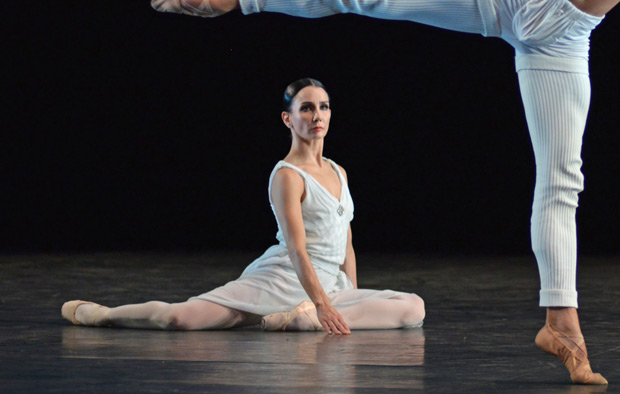
© Dave Morgan. (Click image for larger version)
English National Ballet
The Rite of Spring, In The Middle, Somewhat Elevated and Adagio Hammerklavier
★★★★★
London, Sadler’s Wells
23 March 2017
Gallery of pictures by Dave Morgan
www.ballet.org.uk
www.sadlerswells.com
Four years’ ago, Tamara Rojo’s opening statement – as incoming artistic director of English National Ballet – was a challenging triple bill of iconic twentieth century dance: by Jiří Kylián (Petite Mort); Roland Petit (Le Jeune Homme et la Mort) and Harald Lander (Études). It set out her stall to bring classic modern works to the ENB repertoire, made by great European choreographers who had largely been ignored by British companies. The challenge was all the more difficult because ENB was not yet “her” company; but the one she had inherited.
One might regard this current triple bill as the end of the first cycle of Rojo’s leadership at ENB. A full circle from one programme of Modern Masters, to another; but, this time, performed entirely on Rojo’s terms, by a company that is now well-and-truly shaped by her direction and populated by her dancers. There is a palpable buzz that is in stark contrast to the flat feeling of staleness from a few years’ previously. The passion of these dancers exudes an endearing, seductive appeal; one feels the thirst and ambition to fly higher in everything that they do.
Francesca Velicu symbolises that attractive energy. She is one of the newest recruits and, at 18, certainly the youngest. Rojo gave her a contract (and a soft landing) after the fallout from last year’s rancorous, and unfair, termination of Johan Kobborg’s leadership at Opera National Bucharest. Kobborg can be justly proud of his protégé who painted a vibrant picture of exhausted vulnerability on Rolf Borzik’s horizontal canvas of peat, as The Chosen One, in ENB’s magnificent revival of Pina Bausch’s The Rite of Spring.

© Laurent Liotardo. (Click image for larger version)
Made in 1975, Bausch’s Rite has only even been performed previously by her own company and the Paris Ópera Ballet. Huge kudos, therefore, must be heaped upon Farooq Chaudhry – ENB’s creative producer – for securing this masterpiece. Being allowed to perform this Rite is clearly not a right easily bestowed; and the ENB team rewarded that trust with a bountiful and beautiful dividend. This was as strong and as earthy a performance as I have seen in several encounters with the production as essayed by either Tanztheater Wuppertal Pina Bausch or POB.
Bausch’s choreography turns Stravinsky’s darting, surging music into an intense and absorbing spectacle. 28 dancers – four less than specified in Bausch’s original choreography – are split into equal groups of men and women. At first, the women are alone; one sleeps, centre-stage; her cheeks caressing a blood-red, silk garment: another runs on, diagonally, before stopping abruptly and lifting her dress head-high; two more women run on stage from opposite ends, along a lit, diagonal axis, meeting at midpoint. Women lead each other gently by the hand; they roll and play in the peat; they stretch, flex, moving with an innocent eroticism, in this safe haven, without men.

© Laurent Liotardo. (Click image for larger version)
However, their suspicious focus remains on the red garment lying on the earth: symbolic of death, menstruation or both? One woman picks it up and stares, intently, at the fabric: the others stop still, en masse, suddenly afraid. They assemble into a tightly-knit, highly-disciplined group, standing still, before erupting into aggressive, harmonious movement: arms raised, heads thrown back, legs wide apart before contracting and bending forward in unison; they swivel and turn while one woman detaches from the group, running away to stop at a distance, throwing her shoulders forward and back in hysterical, dislocated movement.
This triggers the arrival of the hunters and as they settle into an ensemble, ritualistic dance with the women; one girl slowly walks away, painfully sad, clutching the red dress, held against her body. The stark symbolism of the splash of red against the dirt gains emphasis as the dress is passed from one woman to another. It’s a childhood game, but more reminiscent of Russian roulette than pass-the-parcel; a devil takes the hindmost that signifies a sacrificial end to the young woman (Velicu) who ends up chosen by these predatory men to wear red.
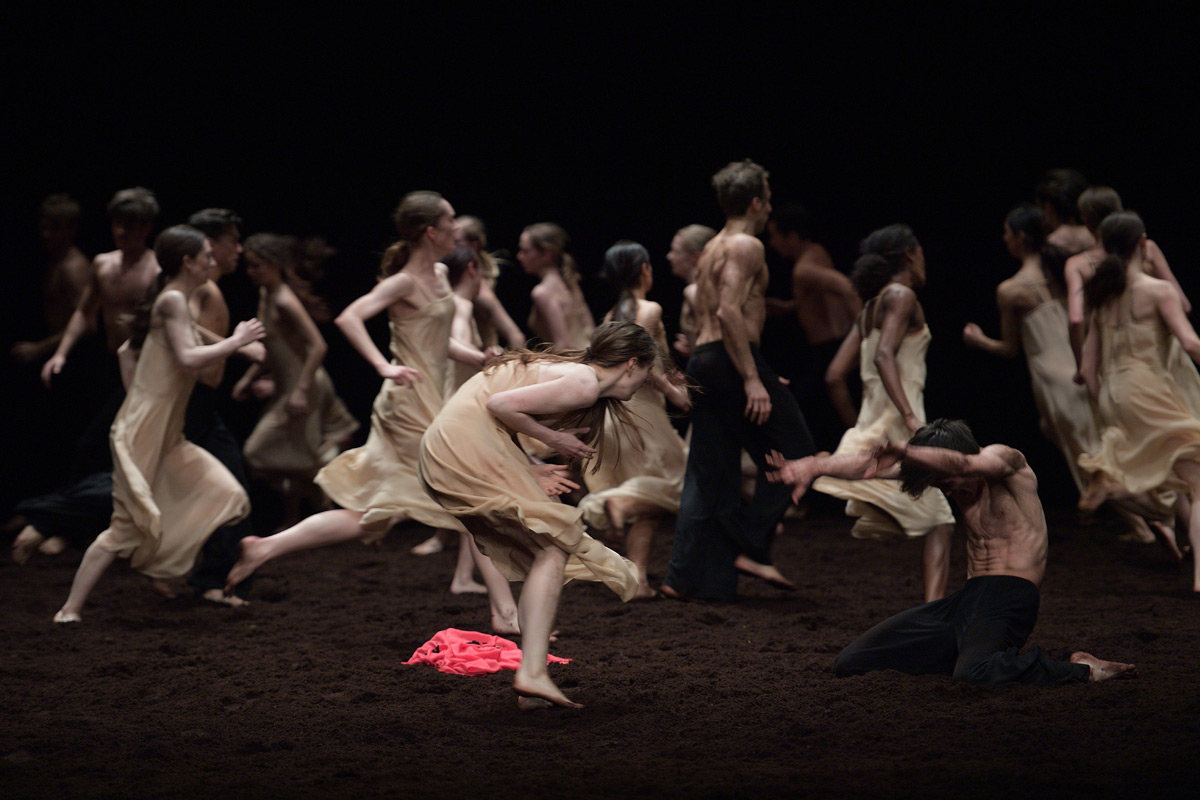
© Laurent Liotardo. (Click image for larger version)
Bausch’s spectacular work is so intense, so primeval that it is easy to imagine being somehow transported back in time, spying on an ancient fertility ritual from behind a rock. This visceral realism is grounded in the peat, providing a simple but effective set, while also generally smearing men and women alike in dirt-stained sweat. That effect seemed strangely muted on this occasion. Perhaps, the peat needs time to age and separate?
The selection and subsequent terror of Velicu as the sacrificial maiden triggers a feral intensity of orgiastic couplings followed by the chosen one’s steadily degrading, exhausting six-minute dance, culminating in the death throes of contorted, introverted movement before an elegant pirouette leads to her climactic collapse. The vulnerability of a terrified young girl, dancing herself to death, one breast symbolically revealed, could not have unravelled with any more emotional potency than in this raw and absorbing performance.
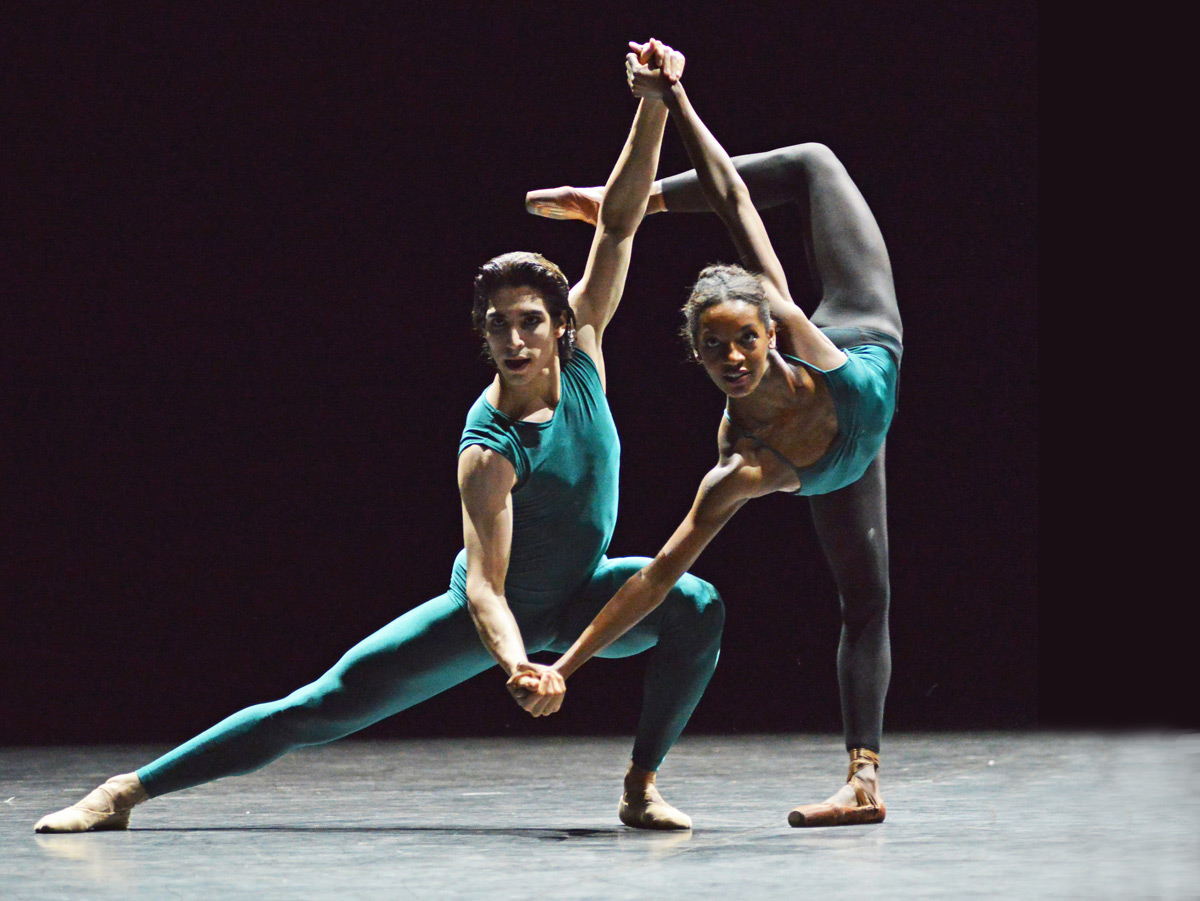
© Dave Morgan. (Click image for larger version)
It was not just a new recruit that shone. Fernanda Oliveira, Fabian Reimair, James Streeter, James Forbat and Crystal Costa all joined ENB in the early noughties, having almost 70 years’ service, between them: and each of these experienced dancers figured prominently. Streeter and Costa enlivened William Forsythe’s seminal masterpiece, In The Middle, Somewhat Elevated with its coruscating, insistent score by Thom Willems. Forsythe’s unique combination of extended classicism and off-kilter balances, mixed into a cocktail of rigorous performance and casual transitions, was captured with verve, flair and authenticity. Tiffany Hedman was a particular revelation, her long legs seemingly stretching beyond plausibility; and Cesar Corrales etched another notch onto his burgeoning reputation with a charismatic, leonine solo that simply demanded attention.
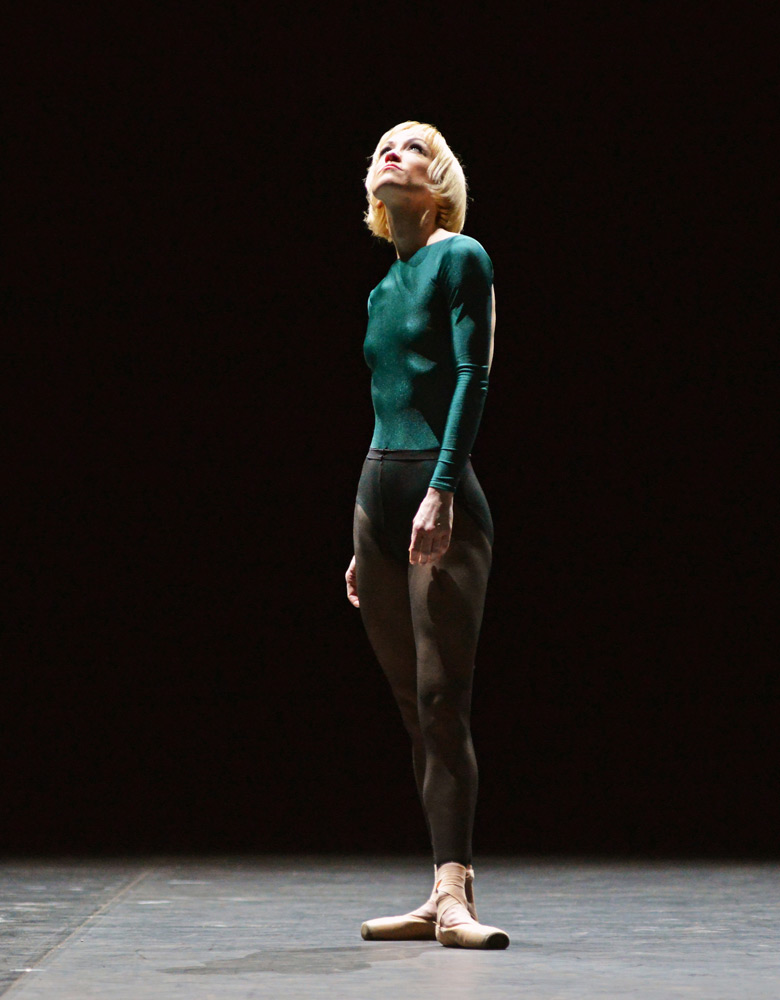
© Dave Morgan. (Click image for larger version)
The bridge between these two arresting works was provided by the gentle series of duets made by Hans van Manen to Beethoven’s Adagio Hammerklavier. A breeze billows the curtained backdrop, establishing a calming environment for his trio of couples. Isaac Hernandez had just assisted the ensemble’s excellence in delivering the exacting standards of Forsythe’s masterpiece and he returned, fresh as a newly-bloomed spring daffodil, to accompany Rojo in the third of the duets, the pair dancing with entwined elegance and a gently-percolating chemistry. Forbat and Oliveira also danced softly, intensely; essaying the fine details of van Manen’s visual interpretation of Beethoven’s piano masterpiece; and Reimair proved that his technique has not been sublimated to the usual fare of character roles, partnering Laurretta Summerscales with cool assurance.
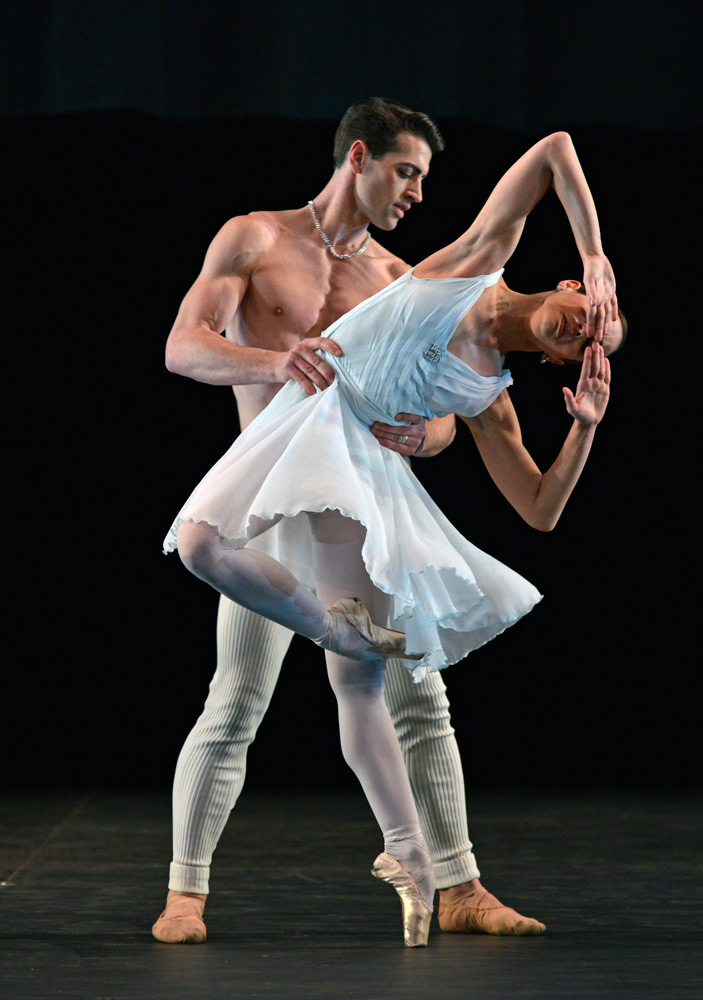
© Dave Morgan. (Click image for larger version)
This was a remarkable and varied programme, always high on emotion but mixing visceral, gut-wrenching intensity with refreshing detachment. At every level, it was given exemplary attention to detail, including exceptional musical performances. Concert pianist, Olga Khoziainova gave a dreamy rendition of Beethoven’s long and challenging piano sonata. The dances were gorgeous but you could have closed your eyes and been carried away on the gentle breeze of Khoziainova’s pianism. And then, we had the treat of ebullience and subtlety in Gavin Sutherland’s direction of the ENB Philharmonic’s performance of Stravinsky’s epoch-making music. Pounding rhythms bounced with youthful zest while engaging the subtle distinctiveness of each instrument.
One cannot help but observe that while the programmes of other companies both hit and miss, in terms of their critical appreciation and popular appeal, ENB is continually raising the bar – under Rojo’s leadership – with an unbroken run of successes.













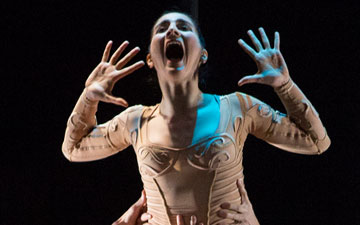
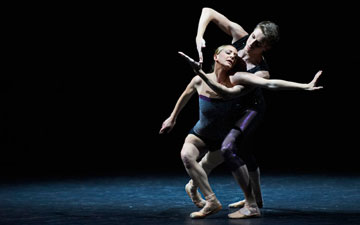

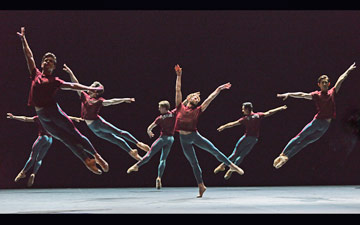
Terrific article on the Triple Bill of ENB – thank you.